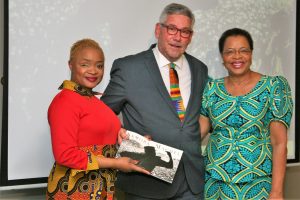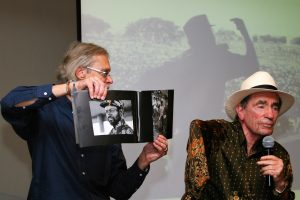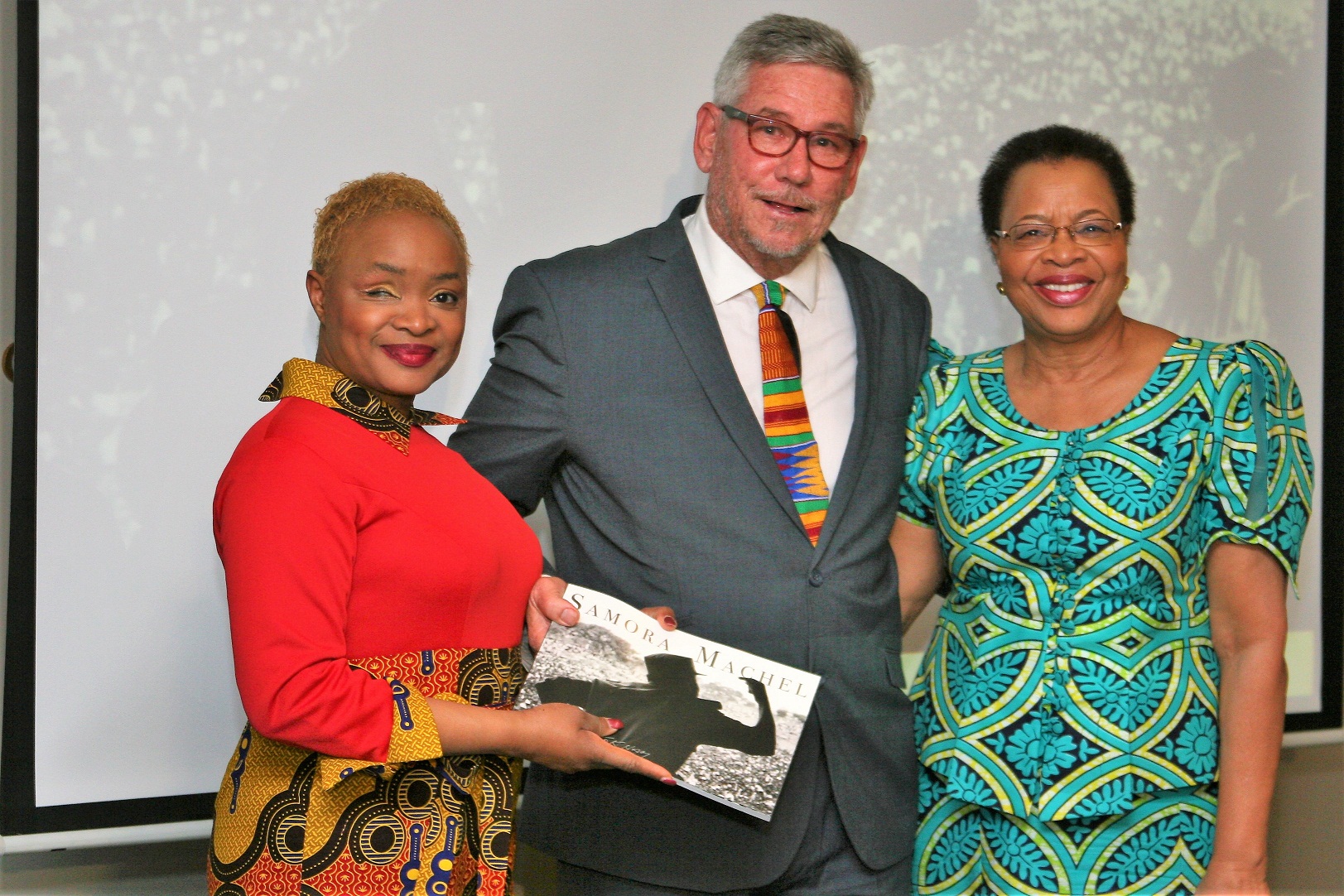That background is contained in Nam’s monochromatic photography book on the Mozambican leader titled: Samora Machel by Kok Nam.

Number 13 in the African Lives Series, an independent writing and publishing initiative which aims to contribute to a postcolonial intellectual history of South Africa, the book – by CTP Printers and under the editorship of Honorary Professor of History and Heritage Studies at the University of the Western Cape, Dr Andre Odendaal [for its English-language edition] – was launched to much fare at the Nelson Mandela Centre of Memory in Houghton, with Graca Machel in attendance.
Also present was a familiar patriarch the local Hellenic community affectionately refer to as, “Papou”, namely, George Bizos – in addition to who’s-who’s such as Albie Sachs, Elinor Sisulu, Buti Manamela, Florence Masebe, Pali Lehohla, Bonang Mohale, Josina Machel and the hosting venue’s CEO, Sello Hatang.
One of the designated speakers on launch night, former South African Justice, Albie Sachs, who lost his right arm as well as sight of an eye in an attempted assassination in Maputo, expounded on the intertwined history his country shared with Mozambique – of how, although he only got away with the loss of a limb, two locals lost their lives in the car bomb incident. “I owe Mozambique my courage”, pointed out Sachs, continuing, “Samora died for our liberation!”
In fact, in the book’s introduction, the erstwhile Constitutional Court principal went further by evoking times shared in the neighbouring southern African nation with comrades such as Ruth First, Rob Davies and Tom Moyane – recalling how they would all feel so proud when Samora would lead the vivas for the just struggle of the oppressed people of South Africa. In written form, he reminded of the immense price that Mozambique paid for supporting South Africa’s liberation struggle!
On the other hand, Machel’s widow, Graca, who alongside her daughter, Josina symbolically accepted a copy of the book from Odendaal– insisted that her late husband and the like of Thomas Sankara, were assassinated. “They thought that killing him would destroy his ideals!” punctuated home the only woman to have been the First Lady of two countries.
The second wife to Mozambique’s first president at independence in 1975 and a minister of education and culture in her husband’s cabinet, Machel in Nam’s book is quoted thus: “Samora had an extraordinary capacity to communicate: with his tone of voice, with his hands, with his eyes, and even with the movements of his body.”
“When you read the book, you’ll identify yourself with the struggles”, she hinted to the audience in Houghton, further urging young people to take the legacy as a tool to understand their society. Thanking the publisher, Odendaal for making the book available to South Africans – Machel drove across the point that “our sophisticated weapon is that we are anti-racism. And leafing through to a page depicting Samora and the late ANC leader, Oliver Tambo clasping hands on a podium at an event, Machel suggested in reference to her first husband, “He is still with us in his thinking.”
Amongst those in attendance on the night also was Alves Gomes, credited as an executive editor in the production of the book and the man unto whom Nam entrusted his collection of Samora Machel images.
A man of erudite posture as he held sway in front of guests at the foundation, Gomes, on the book’s preface, recounted the background to the project, starting with the late photographer handing him an envelope one afternoon in June 2012 – with the specific instruction to keep it in a safe place. That, pointed Gomes, happening after having reminded Nam about still not having done anything with his collection of Samora Machel pictures.
A mere two months later, Nam was gone and thus did Gomes embark on sifting through a world of the lensman’s imagery documenting, inter alia, colonial Mozambique and onto the country’s first multi-party elections of 1994.
The envelope Nam had entrusted into his care, Gomes disclosed, contained what he described as the now late photographer’s masterpiece: an image of Samora Machel taken at the guerrilla training camp of Nachingwea, Tanzania, in 1974.
This was in the form of a print Nam had preserved like a rare diamond, since he had lost the negative thereof. Gomes described the photograph as reflective of the personality of the man most Mozambicans still keep in their hearts and minds – their point of reference for what is right and wrong!
Gomes also let the reader in on the nature of the relationship between the photographer and the statesman – stating that Nam was not afraid to tell Machel what few others dared to say.
Such as an incident when the president invited the photojournalist to help with the rice harvest in Gaza province by swopping his camera for a scythe. Sans hesitation, Gomes recalled, Nam replied that he was there to take pictures while the president ought to comply with his duty of serving the people.
Published in a landscape format, Samora Machel by Kok Nam contains only monochromatic imagery juxtaposed to quotations brimming with definitions of his ideals, values and principles – with Machel’s excerpts understandably outnumbering those by the ilk of the late Lesotho leader, Leabua Jonathan, Kenneth Kaunda, then Bishop Desmond Tutu to even an adversary pending the war for independence, the Portuguese General Costa Gomes, who had this to say about the sworn socialist: “I was his opponent, as Commander of the Military Region of Mozambique. He was a highly respected and valiant adversary, very generous and intelligent, who knew how to conduct operations very well, particularly between 1969 and 1973 … He knew how to deceive, and knew how to choose the place where he wanted to operate.”
Described as a great communicator who when in flow would hold a crowd in lyrical engagement, the pearls of wisdom he dispensed on his sojourns are vividly and generously thrown around the book’s pages.
As though a prophet, considering that he was to perish in a plane crash back in 1986 and some years ahead of South Africa’s transition to a democracy, below an image depicting him clasping hands with then ANC president, Oliver Tambo on a podium at an unspecified event, he rang these words: “History has proved that the aggressor is always defeated. Liberation is an irreversible force … The minority racist, aggressive and colonialist regime will be defeated by the South African people. Apartheid will disappear.”
And not simply because he was selective in his denunciations based on as pertained unto others rather than himself or own domestic affairs – far be it the case with him, for he was exacting of himself also.
“Leaders come and go, but the People never die,” Sachs recalled him telling them. And in another quotation which would rankle the current narrative causing polarization among South Africa’s multi-racial populace, Machel, whose FRELIMO movement wasted no time in implementing Marxist-Leninist measures across the People’s Republic of Mozambique, expounded: “Our independence will make no sense while our land remains in the hands of a few people: that means that we are still not independent, that people are still not liberated.”
From a fellow artist’s perspective, the author of this article, whose own work happens to appear with that of Nam in a 2000 book by Australian scholar, Margaret Waller, titled, A Bigger Picture: A Manual of Photo–Journalism in Southern Africa – wondered what would the photographer, of whom it’s noted in his book that he preferred developing and printing his own work, had made of the mostly head and shoulder picture selection of the subject.
Maybe Gomes, in his role as the executive editor and the photographic editor, Joao Costa, intended it thus, with the mentioned matching of each photo with quotations from Machel’s speeches. Or peradventure one’s answer to one’s question lies in Gomes’ claim that it would not make sense to publish Kok Nam’s pictures without linking them to expressions of Samora Machel’s ideological values and principles.

Apart from the misgiving, extending to the missed opportunity of including snapshots of Machel and his family, Nam’s book – naturally also available in Portuguese [published as a 1st edition in 2016, in Maputo] – bursts with affirmative text and illustrations of a late 20th Century spellbinding figure in varying moments of, one suspects, a fulfilled Life!
Reminiscent of the animated poise of a Fidel Castro suitably clad in military gear, the book’s cover lures a potential reader with an image of Machel, back to the camera, gesticulating with what became to be regarded as his famous finger as he drove a point home toward a vast crowd gathered below.
Perusing along through the pages, one will also come across a Kalashnikov-toting Machel seemingly in revolutionary cry and conversely, a scythe in hand, about to wade into a field populated by workers in the background [most probably recorded by Nam pending the incident where he defied the president]. Another moment depicts Machel hoisting aloft a young girl who appears to be of Portuguese extraction, with someone who looks like the young one’s mother, smiling whilst simultaneously staring in the camera’s direction.
Samora Machel and Oliver Tambo clearly shared ties which bound – what with their association with the Reggio Emilia region of Italy?
Pending the exile period, Tambo and the ANC survived with the assistance of the folk of that region, in what came to be known as the Reggio Emilia Hip Alliance. Machel too, came to forge solidarity with the city within the context of a conference against colonialism and imperialism for freedom and independence of Mozambique, Angola and Guinea Bissau. As gleaned from Wikipedia, according to Joe Slovo, a young Machel once made such an impression on J.B. Marks that the senior ANC official bumped one of the movement’s recruits off a flight enroute to Tanzania – just so as to let the Mozambican on.
Given the present shape of the movement they sacrificed so much for, Tambo, Slovo and Marks would have approved of this typical thunder from Machel: “If the brewery worker can take beer home, if the poultry worker can take chicken home, then the cashier can take money home. That is theft!!! Corruption leads us to vice, and this leads us to crime. An ambitious person is a criminal.”
On the penultimate page of the book is an image dated the 19th October 1986, the very same day Machel perished in a plane crash at Mbuzini. In it, White South African policemen are captured sifting through parts of the wreckage, with a colleague standing in the foreground donning a T-shirt inscribed with the words: Terrorism stops here!
Asked Alves Gomes on the preface: Has anyone seriously considered that premeditated threat?
Described in 2010 by Mozambique’s Minister of Culture, Armando Artur, as “the living memory of Mozambique”, Nam, who died in 2012, was the son of Chinese emigrants who settled in Mozambique at the beginning of the 20th Century.
Born in the then Lourenco Marques [present day Maputo] back in 1939, Nam began his journalistic career at the Focus studio, at the age of 16 and was later invited to join the team of journalists on Diario de Mocambique. He also worked for Noticias da Tarde where, according to Wikipedia, he became friends with Ricardo Rangel – a well-known Mozambican photographer.
1970 saw Nam and a group of other journalist found the magazine, Tempo, which was opposed to Portuguese colonisation and at which he reported on FRELIMO goings-on. Upon the fall of the autocratic regime in Portugal in 1974 – the magazine followed an openly leftist course towards the independence of Mozambique.
In 1990 Nam was one of the leaders of a group of journalists who wrote the document, “The Right of the People to Information”. It was the precursor to the current law on press freedom in Mozambique.
From Nam’s archive comes a series of photographs which document important phases from the beginning of the history of independent Mozambique, ranging from the period of the nationalizations, through the liberation war of Southern Rhodesia, the creation of agricultural cooperatives and communal villages, to the civil war which ripped the country apart for 16 years.
Kok Nam left a rich series of portraits and photographs of Samora Machel which well reflect the personality of an essential figure of the Mozambican motherland.
His work has been exhibited at home and in Denmark, France, Italy, Portugal, Sweden and Zimbabwe – as well as having appeared in The New York Times, Time Magazine and The Observer, among others.

